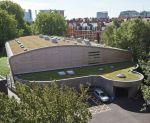
The new Little Venice Sports Centre in Crompton Street, London appears to grow out of the surrounding park. The building achieves high levels of sustainability, most notably through bio-diversity, energy efficiency and eco-friendly materials such as its sedum roof, which is also a focus for two other important energy saving technologies – Monodraught Windcatchers and Sunpipes.
Designed by LCE Architects for Westminster City Council, the 2,720sq m sports centre services local schools and provides a modern amenity in the local area, offering flexible activity spaces and a dedicated adult learning hub. The entire project incorporates a range of sustainable features such as the roof-mounted Sunpipes and Windcatchers, which provide natural lighting, ventilation and cooling and contribute to the creation of a very low energy building.
Explaining the reasoning behind the use of natural daylight, Mark Hewitt of LCE says the Monodraught Sunpipes diffuse daylight, avoiding problems such as glare and contrast that are often experienced with direct sunlight from windows, and which can interfere with sporting activities.
“It means we can bring as much light as we want into the building and it doesn’t interfere with any of the centre’s activities, even in the sports hall. Sunpipes are a very efficient way to bring light into interior spaces, whilst avoiding glare and heat gain, and the building is more secure as there are fewer windows that can be used to force entry.”
He also quotes visitors’ reactions to the educational suite and meeting room that is lit entirely with Sunpipes during the day: “What surprises people is the quality of light from the Sunpipes during daylight. It really is good and people are very happy with the natural light.” He adds that a windowless internal baby-change room is fitted with a Monodraught Monovent, which combines the Sunpipe for natural lighting and a Windcatcher for natural ventilation. “It provides daylight for changing whilst also maintaining a fresh atmosphere.”
“For aesthetic and security reasons the building had been designed with very few windows, so natural ventilation was always going to be the most sensible solution for the sports hall and main spaces. Monodraught supported us with all the data and technical guidance we needed to demonstrate to the client that the Windcatcher system was suitable for this type of facility. We were also encouraged by the fact that it is a very straightforward system with few moving parts that could go wrong or create noise. Being able to manage the system automatically was also a big advantage as is the night time cooling facility, which purges the building, leaving it fresh for the next morning.”
Besides the significant energy cost and environmental savings, other significant savings were also made. Installation costs were reduced because the system is fitted directly through the roof, with only a short distance to the ceiling diffuser. This meant it was easier to install than mechanical ventilation and there was no extra cost for a suspended ceiling to hide the system. Another benefit from the use of sustainable technologies such as Windcatchers and Sunpipes is that LCE was able to reduce the size of the plant room. During the original planning for the project, provision was made for a 90sq m plant room, which was considered normal for this type of facility. However, Mark Hewitt says LCE actually managed to meet the needs of the centre with a 55sq m plant room, which is a significant improvement both in terms of initial cost and running costs, not to mention saving space itself in London.
Aesthetically the Windcatchers also worked well with the LCE design both internally and externally. The roof mounted units were based on an existing Monodraught design but the cappings were redesigned to emphasise the profile, and the bases needed to vary depending where they were fixed on the roof.
None of the areas served by the Monodraught equipment has opening windows so the Monodraught natural ventilation systems, which are fully automatic and proven over more than 15 years, were the preferred choice for the building.
